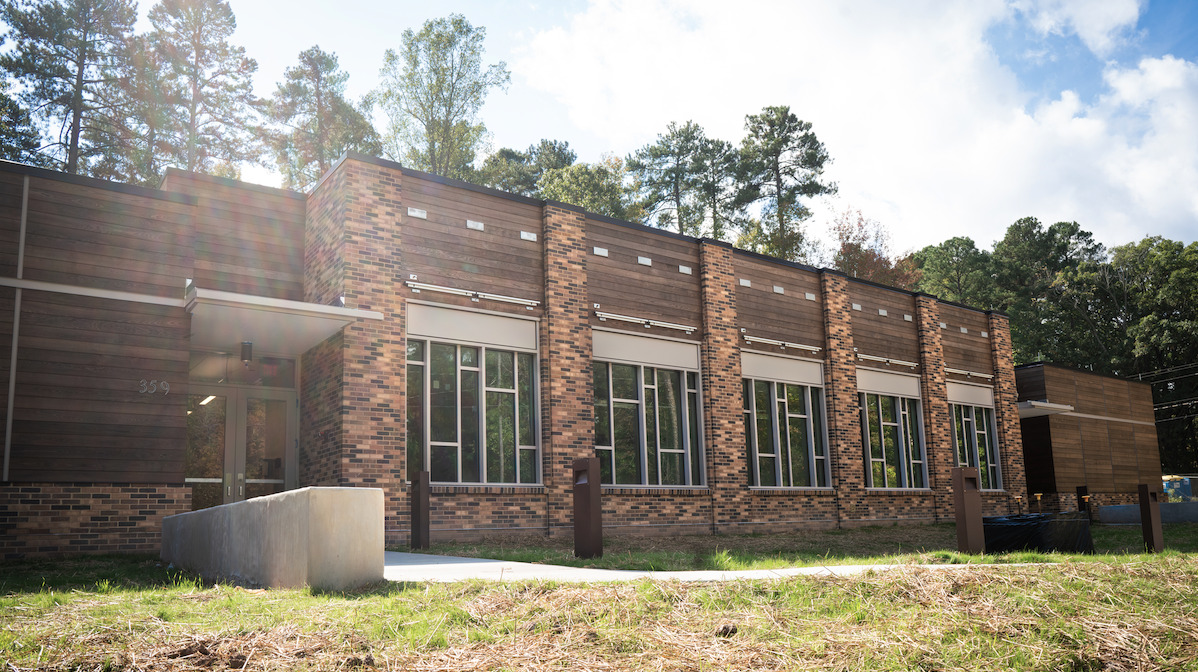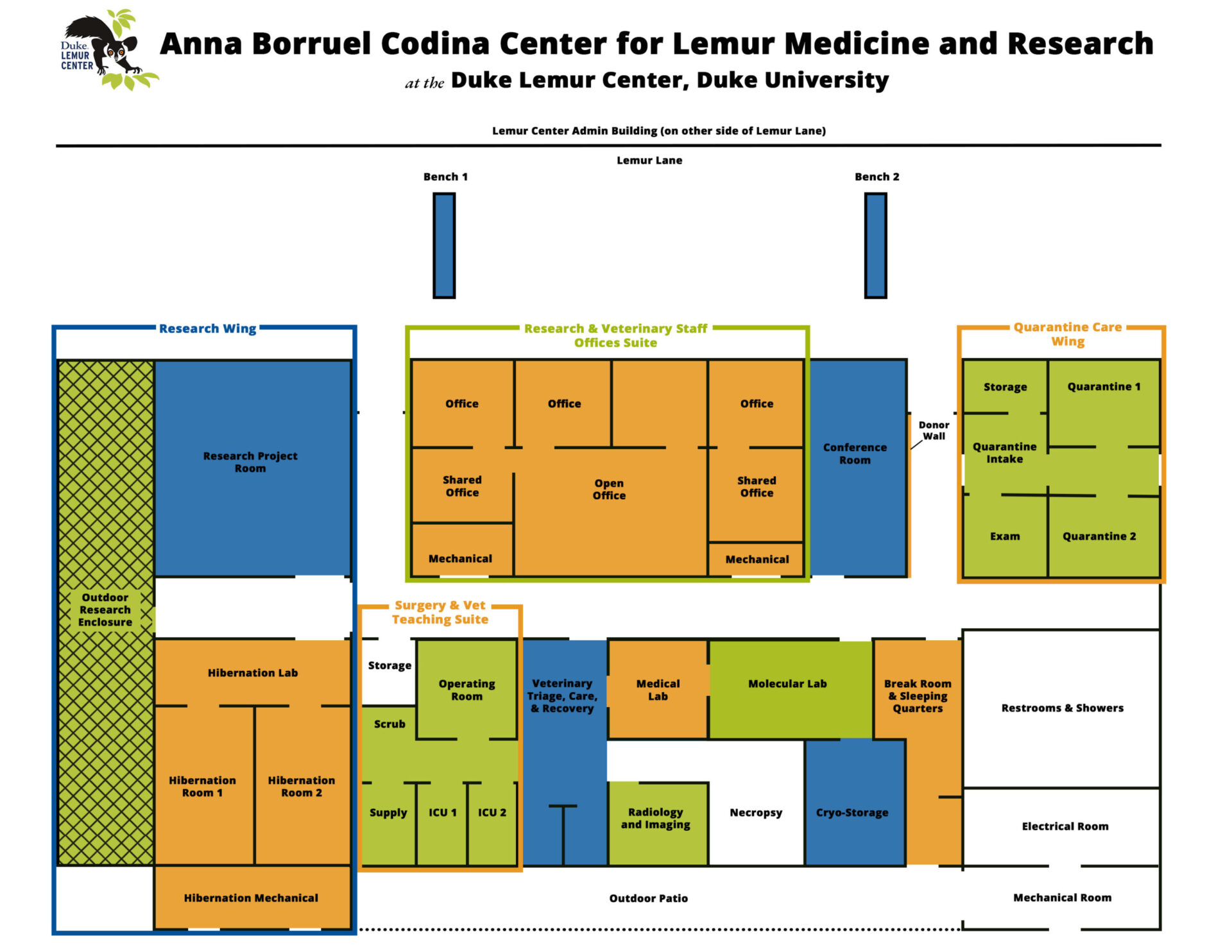Building the Future:
A New Era of Studying and Caring for Earth’s Most Endangered Mammals
By Sally Bornbusch, Ph.D. and Sara Clark
Published September 29, 2021
Read the full article with photographs in the DLC’s 2021 annual magazine
This fall, the Duke Lemur Center celebrates a transformational moment in its 55-year legacy of studying and caring for lemurs: the grand opening of the Anna Borruel Codina Center for Lemur Medicine and Research.
Made possible thanks to an $8M gift by an anonymous Duke alumnus whose family has a passion for lemurs and wildlife protection, the 8,000-square-foot structure provides cutting-edge facilities and technologies tailored to complement the DLC’s world-class veterinary and research programs.
By combining veterinary care and research spaces within the new building, the DLC will maximize the outcomes of both programs.
“Not only is the Lemur Center advancing the science of lemur medicine, we’ve also pioneered a research program focused on non-invasive techniques,” says Greg Dye, the Executive Director of the DLC. “These are strategies that yield high-quality scientific data while also maintaining the highest standards of care for the animals.
“The Borruel Center was designed to house both our veterinary and research programs,” Dye said. “They fit together. They prove that we can be advocates for lemur health and welfare, and at the same time be a leader in research.”
Advancing Veterinary Science
Since 1966, the Lemur Center’s veterinarians have cared for more than 4,000 lemurs and shared their expertise with zoos and conservation organizations worldwide. With surgery and intensive care suites, dedicated quarantine and recovery spaces, and advanced radiography and microscopy equipment, the Borruel Center more than triples the size of the DLC’s existing veterinary facilities and will allow the veterinary team to strengthen and expand their already robust teaching programs and high levels of animal care.
“In the past, we’ve always relied on surplus equipment and had to make do with very limited space,” says Cathy Williams, D.V.M, a veterinarian for 26 years at the DLC. “I never thought I’d be here when a new building was constructed. It opens up so many opportunities.”
“The Lemur Center’s veterinary team has been recognized as the world’s leader in lemur medicine,” says Dye. “The Borruel Center gives them the infrastructure that complements their skill level. They’re world-class vets, and they deserve world-class facilities.”
Elevating Research
Alongside the new veterinary spaces, the Borruel Center houses cutting-edge scientific research facilities, including a molecular lab and fully equipped hibernation rooms, called hibernacula.
In addition to two DLC research scientists who run extensive in-house research programs, the DLC’s research team accommodates an average of 80-90 external research projects annually. “These new spaces will enable the Lemur Center to take our own research programs to the next level,” explains the DLC’s Director of Research, Erin Ehmke, Ph.D. “They’ll also increase the scope and diversity of the projects we can accommodate, as well as intensify the level of mentorship we can provide to student researchers.”
Specifically, the new hibernacula will greatly promote research on hibernation, one of the DLC’s primary research focuses. The Lemur Center is home to 30 fat-tailed dwarf lemurs—the world’s only truly hibernating primates. The hibernacula will allow researchers to control aspects of the lemurs’ environment, such as temperature, to mimic the natural conditions that modulate hibernation in the wild.
“Having these new hibernacula, we will be able to replicate, to a degree, the dwarf lemurs’ experiences in Madagascar,” says DLC research scientist Marina Blanco, Ph.D. “We can bring a little bit of Madagascar into the DLC.”
By promoting successful hibernation in the DLC’s dwarf lemur colony, Dr. Blanco’s research will not only improve the lemurs’ care and health, but could also inform biomedicine, in the treatment of diabetes and other metabolic disorders, or even understanding mechanisms that delay aging.
Fostering Collaboration
Beyond contributing updated spaces and equipment, the building serves another invaluable function: It provides the physical infrastructure and a centralized location that will encourage a robust collaboration between the Lemur Center’s research and veterinary science programs.
“We’re really excited about what this means for making the veterinary team more accessible to researchers, in a collaborative effort,” says DLC veterinarian Laura Ellsaesser, D.V.M. “The topics our research scientists are studying have major implications for how we care for our lemurs. This isn’t just egghead science; there’s true application to it as well.”
“We’re learning a lot, and we obviously have so much more to learn,” says Williams. “What does the microbiome look like in a wild lemur versus a lemur here in Durham? How can we maintain these species in captivity in a manner in accordance with what they evolved to do, metabolically?”
The benefits are mutual. For example, not only can the research performed by DLC research scientist Lydia Greene, Ph.D. on the nutritional ecology of lemurs in Durham and in Madagascar inform the diets provisioned to Lemur Center’s colony, but also the veterinary perspective on lemur physiology and medicine can be applied to better understand the results of Dr. Greene’s studies on lemur gut microbiomes.
Ultimately, by promoting the collaboration and mentorship of scientists and veterinarians that visit the DLC from around the world, the Anna Borruel Codina Center for Lemur Medicine and Research will lay the groundwork for expanding the DLC’s programs that improve the care and conservation of lemur populations within human care and in their natural habitats in Madagascar. “2021 marks the DLC’s 55th anniversary,” says Dye. “This building really kicks off the foundations we’re putting in place for the next 55 years of groundbreaking lemur research and care.”



